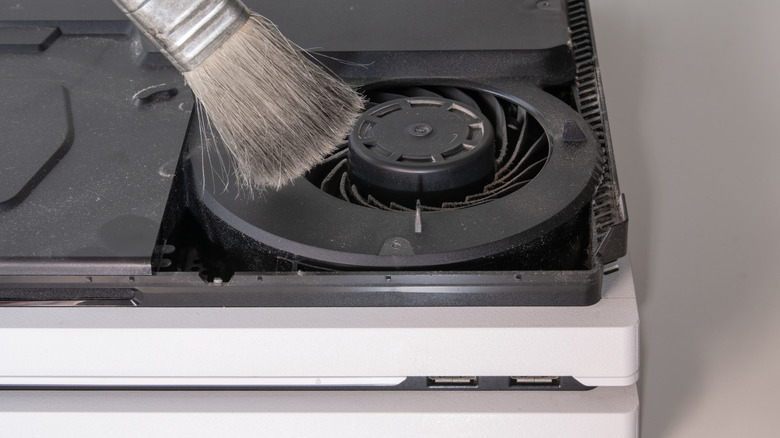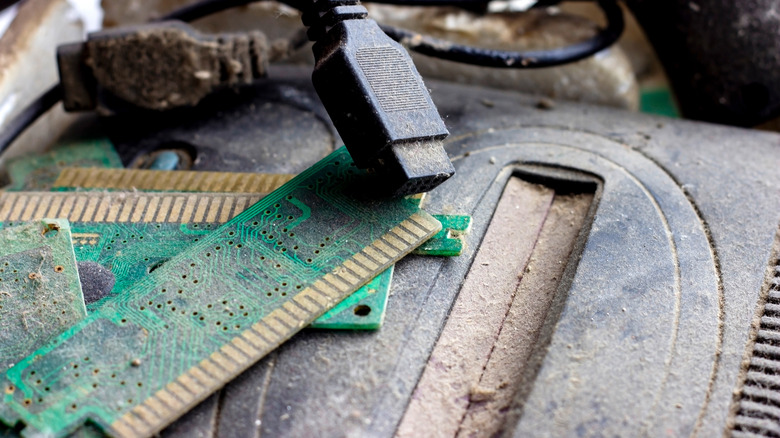How Often Should You Clean Your Gaming Console To Avoid Dust Buildup? Here's What You Need To Know
Console gaming makes up a significant portion of the entertainment industry, accounting for billions of dollars in revenue annually. After all, consoles aren't just gaming machines; they can also double as media hubs for streaming services like YouTube and Netflix. Given that your gaming console might be the most expensive gadget in your home, you'll want to maintain it properly to get the most out of it. And while there are many ways to do it, one of the easiest yet effective ways is to ensure that your console is clean.
By cleaning your console, we don't mean uninstalling titles you don't play; rather, using an air compressor to remove debris and dust caked inside the console. After all, unless you always keep your console completely sealed — which you should never do — it'll inevitably get dirty. And if cleaning your console is not a task you have in mind, dust will build up over time and choke airflow. As a result, your machine will overheat, and you will probably see reduced performance, unexpected shutdowns, and even worse, gradual damage to your machine's delicate components. That's why keeping your console dirt- and dust-free is crucial — not just for looks, but also for performance and longevity.
How often should you really clean your gaming console? There's no hard-and-fast rule for how often you should clean your console, but experts recommend cleaning your gaming console, whether it's a newer machine or a used retro console, every week or so. However, this is subject to change depending on your living conditions. For instance, those with roommates who vape and smoke should expect to clean their consoles more often since cigarette smoke residue will settle on the console's fan, so you'll want to clean it more often.
How to properly clean your gaming console
While cleaning your gaming console has some huge benefits, it can do more harm than good if you do it wrong. One of the most crucial details is that not all gadget cleaning solutions are ideal for your console. Of course, a quick online search for "console cleaners" will reveal a multitude of options. However, before you add one to your Amazon cart, know that warm water mixed with some dish soap will do the trick. You'll also want to avoid window cleaners, household cleaners, and even vinegar, as they can potentially damage your console.
Electric air dusters and compressed air are quite effective in removing dust from hard-to-reach areas, but they also have their caveats. For instance, you'll want to be careful with how you blow the air, as the pressure can cause damage to other components. Even worse, you might push the dust further into the console or damage the fan from rapid spinning. To avoid this, use a microfiber cloth soaked in water or an isopropyl alcohol solution and gently wipe down the clogged areas. You can also use a soft brush (say an old toothbrush) or Q-tips to remove stubborn clogs on the fun and vents before wiping them clean.
How to know when you should clean your console
It's easy to forget to clean your console, but you'll want to know the signs for when it's time for a clean-up. The first thing you'll want to consider is the sound produced by your console. If the fans start to sound like a jet taking off every time you launch a game, that's a clear indicator that the fans are struggling to push air through layers of dust.
Another common sign that your console needs cleaning is when it starts to feel unusually warm as you play. This normally happens when dust clogs the air filters, and luckily, you don't need to disassemble your console to solve this issue. If your console has been sitting in a tight entertainment setup, you will want to lightly vacuum the fans and vents. Also, you'll want to relocate your console to a well-ventilated area, away from enclosed cabinets and cramped spaces.
Sometimes, one of the easiest ways to know that your console needs a good scrub is visible dust around major components — like USB ports, vents, or edges of the top covers. Luckily, you can easily clean visible deposits with a soft brush or a microfiber cloth. However, if dust build-up is excessive, you'll want to use compressed air, but be extra careful not to spin the fan.


